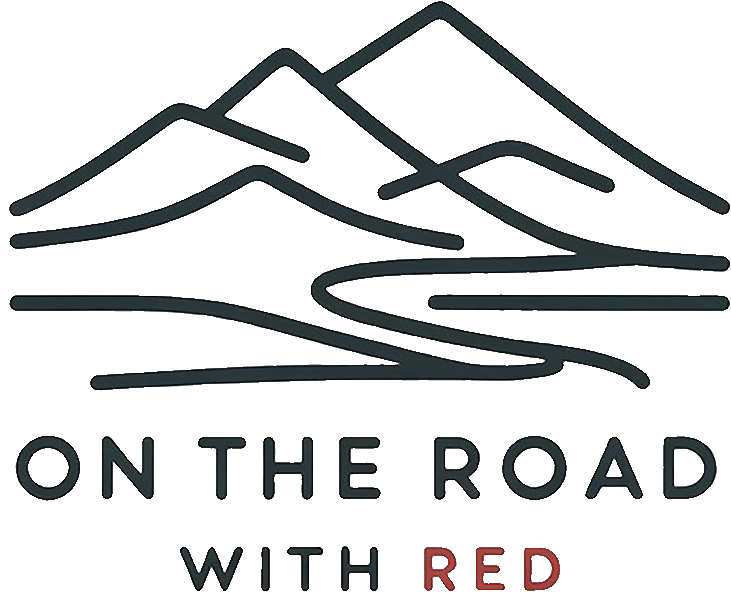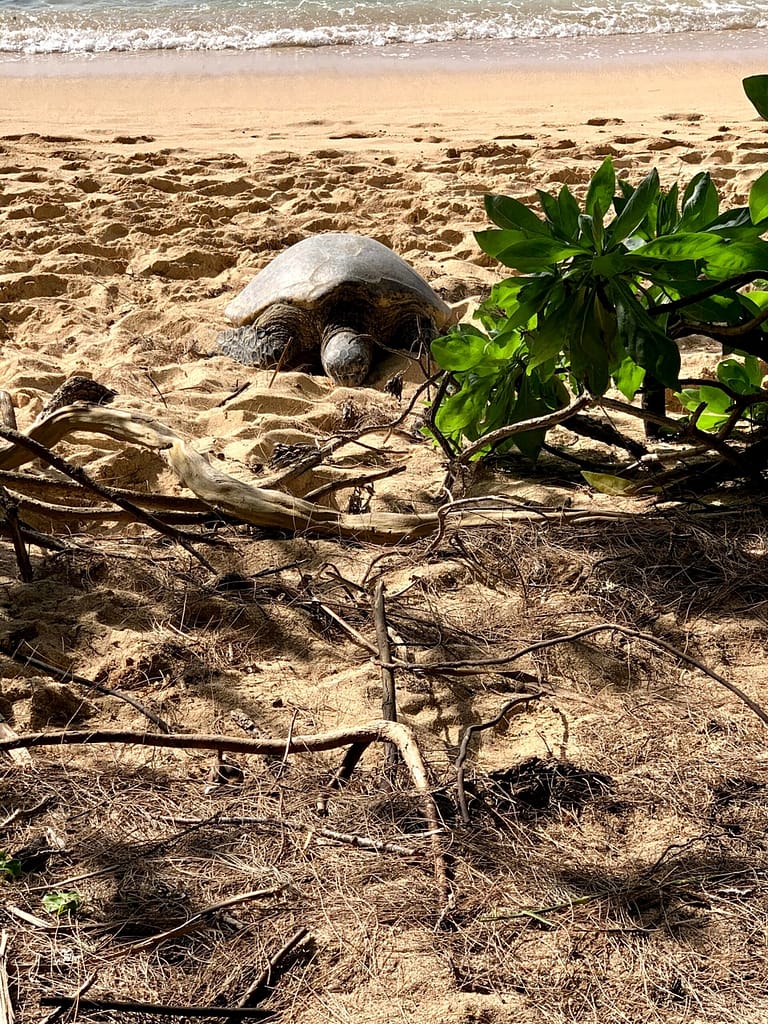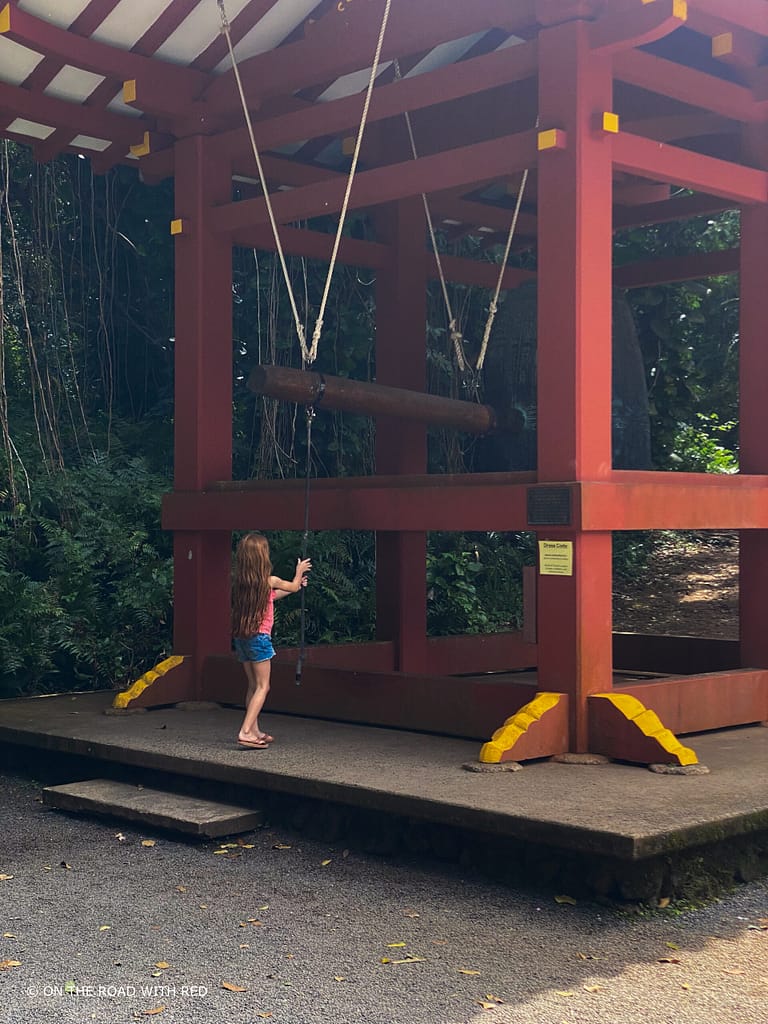
Protecting the Hawaiian Monk Seal
Protection of the Hawaiian Monk Seal: History and Threats
The Hawaiian monk seal, known as ‘ilio holo i ka uaua’ in the Hawaiian language, is a marine mammal that has roamed the crystal clear waters of Hawaii for thousands of years. Now, this amazing creature stands among the most endangered marine mammals globally, with its numbers decreasing year by year. In this post, we’ll explore the Hawaiian monk seal’s significance. We will also delve into its history, and outline the major threats it faces.
A Dive into History
The Hawaiian Monk Seal holds a revered place in Hawaiian culture and mythology. It often symbolizes a guardian spirit and the ocean’s bounty. Sadly, this ancient species faces an unsure future due to various human-induced factors.
Native to Hawaii, this seal is one of the few living in tropical waters and known scientifically as ‘Neomonachus schauinslandi’. The monk seal has been a part of the Hawaiian archipelago for more than 15 million years and features in local folklore. Their existence was first recorded by European explorers in the 1800s. This discovery marked the beginning of their decline as they were hunted for their skins and oil. By the 20th century, their numbers had drastically reduced due to hunting, human disturbance, and habitat loss. Thus making them one of the most endangered seals in the world.
The importance of Hawaiian monk seals extends beyond their charm. They also play a crucial role in maintaining the health of coral reefs and are an integral part of Hawaii‘s natural heritage. We can all contribute to their survival by respecting their space on beaches, supporting conservation organizations, and spreading awareness about their situation.
The story of the Hawaiian monk seal is more than just a tale of an endangered species. It’s also a call to action and a reminder of our responsibility to protect our natural world. It’s in our hands to ensure that these magnificent creatures continue to be a part of Hawaii’s unique ecosystem.
The Perils Facing the Hawaiian Monk Seal
Habitat Loss
Primarily residing in the Northwestern Hawaiian Islands, the monk seal’s habitat is threatened by rising sea levels and climate-induced degradation. This loss of critical habitat significantly threatens these seals.
These seals depend on pristine beaches and undisturbed coastal areas for key life processes such as resting, molting, and nurturing their pups. Unfortunately, their habitats are increasingly under siege. Climate change is a major culprit. Rising sea levels and changing weather patterns lead to beach erosion and loss of coastal land, directly impacting the seal’s natural habitats.
Erosion
The erosion of coral reefs, another critical habitat for Hawaiian monk seals, further complicates their survival. Coral reefs provide food and shelter for the seals. But factors like ocean acidification and coral bleaching are diminishing these vital underwater ecosystems. The compounding effects of habitat loss and environmental degradation pose a significant risk to the Hawaiian monk seal population.
Conservation efforts are underway to address these challenges, focusing on habitat protection, legislation, and public awareness campaigns. These initiatives are crucial to prevent further decline of the species. Thus ensuring that Hawaiian monk seals have a fighting chance for survival in their natural environment.
For more in-depth information about climate change impacts on marine life visit the NOAA‘s Hawaiian Monk Seal Conservation Program.
Entanglement
Entanglement poses a serious threat to the Hawaiian monk seal. It is a critical issue that underscores the broader problem of marine debris in our oceans. These seals, curious by nature, often become trapped in discarded fishing gear, like nets and lines. This can lead to severe injuries or even death.
The problem is not just limited to fishing equipment. Everyday items like plastic bags and packing straps also contribute to this peril. Young seals are particularly at risk. Their inquisitive behavior makes them more likely to interact with and get caught in debris. Entanglement incidents are distressingly common and have been increasing in frequency, reflecting the growing problem of ocean pollution.
Rescue operations by conservationists are often required to free these entangled seals, but these are risky and not always successful. Reducing ocean debris is essential, not only for the survival of the Hawaiian monk seal. Also for the health of marine ecosystems as a whole.
Conservation efforts focus on cleaning up beaches and waters, as well as promoting responsible fishing practices. However, the long-term solution lies in a global commitment to reducing waste and protecting our oceans. The Marine Debris Program offers more insights into this issue.
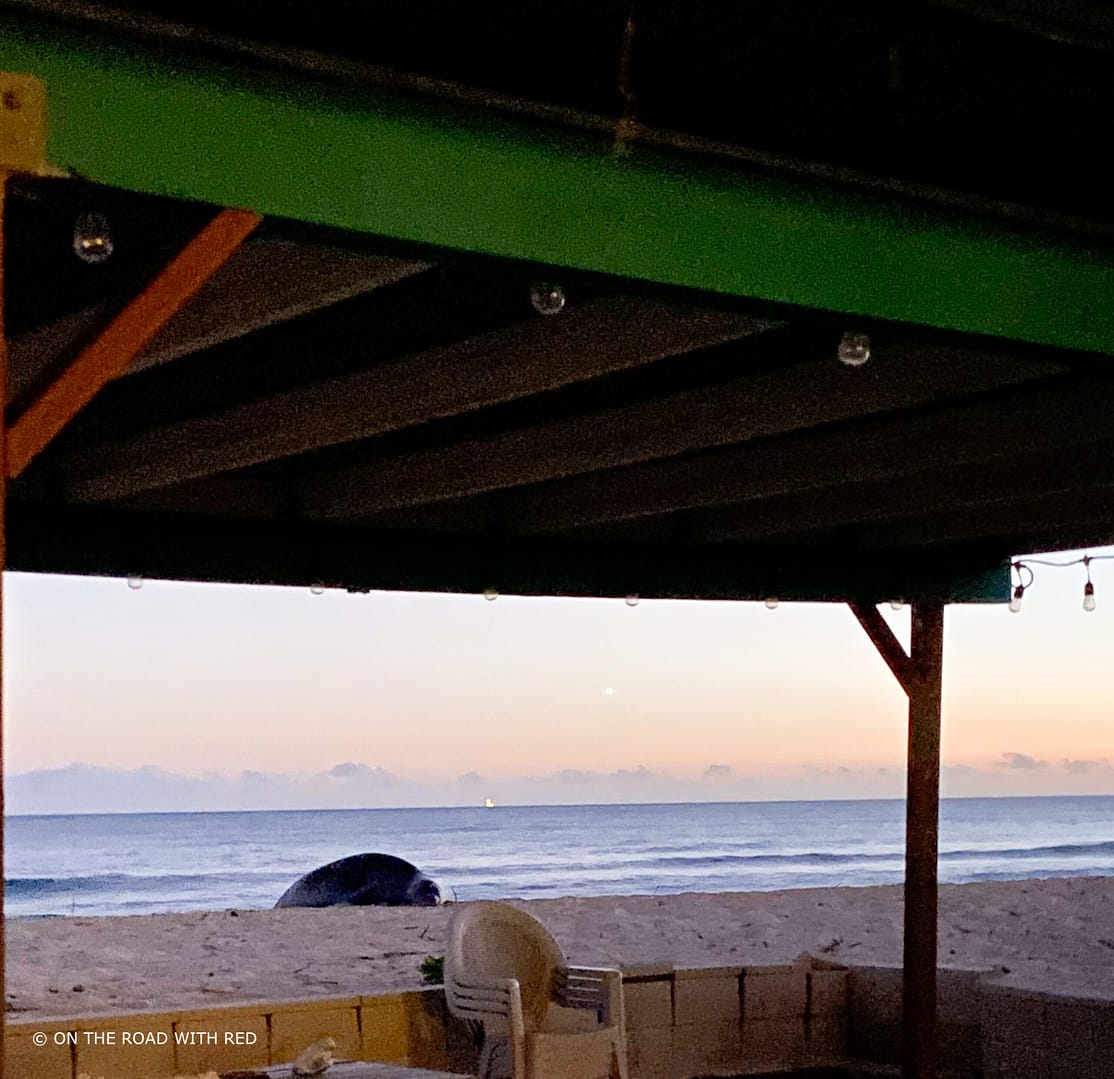
Human Disturbance
Human disturbance is a significant challenge for the Hawaiian monk seal, a species already grappling with the perils of endangerment. These disturbances come in various forms, ranging from direct interactions like harassment and feeding by beachgoers, to indirect impacts such as noise pollution from boats and coastal development.
As someone who has witnessed this firsthand, I have very strong feelings about the matter. As visitors to the islands, it is imperative to educate yourself on conservation efforts. Many people are respectful and mindful. Others put themselves, the seals, and others at risk. Also, for full disclosure, if you harass a seal you will end up on social media. There are many social media platforms with groups dedicated to the protection of the seals. Also, local community groups will quickly spread the news and pictures of the harassment of seals. It is a gift to have the opportunity to see these amazing mammals in person. With that gift comes the responsibility of minimizing your impact on them.
Such disturbances can have profound effects on the seals’ natural behavior, causing stress. This disrupts their resting and foraging patterns and even leads to habitat abandonment. Particularly concerning is the impact on mother seals and their pups. These disturbances can lead to mothers abandoning their pups or pups being injured in the chaos.
Health Impacts
Increased human presence on beaches often leads to seals being disturbed during crucial resting periods. Thus impacting their health and energy reserves. The challenge extends to the conservation efforts, as human disturbance can hinder monitoring and research activities aimed at protecting these animals.
To mitigate these issues, there is a growing emphasis on public education and awareness campaigns. Also, stricter regulations and enforcement to minimize human-seal interactions. The goal is to foster a coexistence where the Hawaiian monk seal can thrive in its natural habitat, undisturbed by the encroaching presence of human activity.
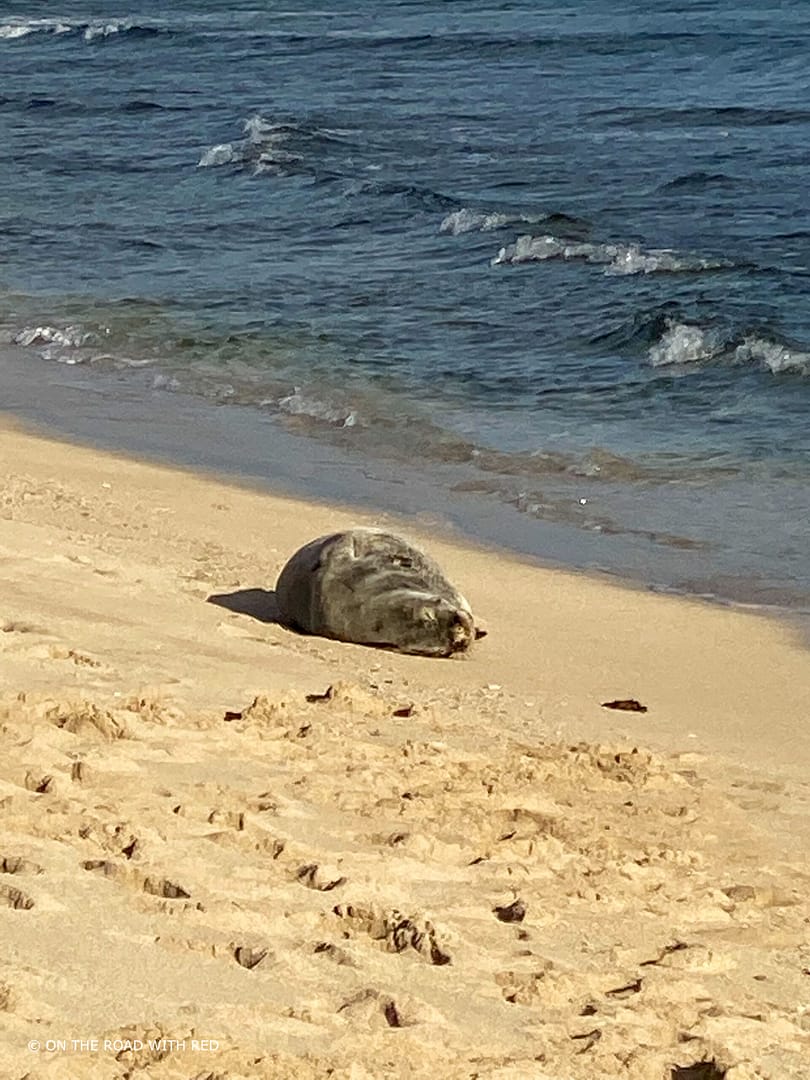
Overfishing
Overfishing is a critical concern for the Hawaiian monk seal population, exerting a considerable impact on their survival. As fish stocks decline due to overfishing, these seals, who primarily rely on fish and cephalopods for food, struggle to find enough to eat. This scarcity of food resources can lead to malnutrition and lower reproductive rates. Thus, directly affecting the health and growth of the seal population.
The competition for food is heightened not just among the seals themselves, but also with commercial fisheries, exacerbating the problem. Overfishing also disrupts the balance of the marine ecosystem. This leads to changes in prey availability and distribution, further challenging the feeding habits of the Hawaiian monk seal.
The reduction in fish stocks affects not only the current generation of seals but also has long-term implications for their future survival. Conservationists and scientists emphasize the importance of sustainable fishing practices. The establishment of marine protected areas ensures a balanced ecosystem where both fish and monk seals can thrive. Learn more about the effects of overfishing on marine ecosystems from the World Wildlife Fund.
Disease
Disease presents a significant threat to the Hawaiian monk seal population, compounding the challenges faced by this endangered species. In recent years, there has been a growing concern over diseases such as toxoplasmosis, a parasitic infection often spread through cat feces. It has caused numerous deaths among Hawaiian monk seals. This disease is particularly alarming because it affects their organs and can be fatal. It is especially dangerous to pregnant females and younger seals. There is a huge feral cat population on the island of Oahu. This issue has led to significant discussions about disease prevention. There are many groups dedicated to the spay and neutering of cats and even off-island adoptions.
Another concern is the potential for disease transmission from human activities or other animals. Monk seals are susceptible to pathogens common in both domestic animals and humans. The spread of diseases is exacerbated by the monk seals’ tendency to congregate in certain areas. Thus increasing the risk of transmission among individuals.
The impact of these diseases is not only immediate in terms of mortality but also long-term. It can affect reproductive rates and the overall health of the population. Conservation efforts are focused on monitoring the health of the seal population, controlling the spread of pathogens, and educating the public about minimizing disease risks. Research into disease prevention and treatment is also a critical aspect of protecting this vulnerable species.
Personal Experience
The pictures below bring many mixed emotions. After arriving in Hawaii, this was the first Hawaiian Monk Seal we saw. We were in complete awe. I asked the volunteer standing guard so many questions and immediately learned all we could to help be stewards for these amazing creatures.
I learned that this specific seal was named Pohaku (tag number RO28) and that she frequented the Ko’Olina Lagoons as a resting spot. This was in 2019. Seals are identifiable by many means and she had a distinctive round mark on her back from a cookie-cutter shark bite.
I was devasted to learn less than a year later that she was suffering from Toxoplasmosis. We followed her progress and sadly she passed away from the illness. Not only was it devastating as we felt we had a special connection, but it showed the fragility of these creatures and how critical their numbers are.
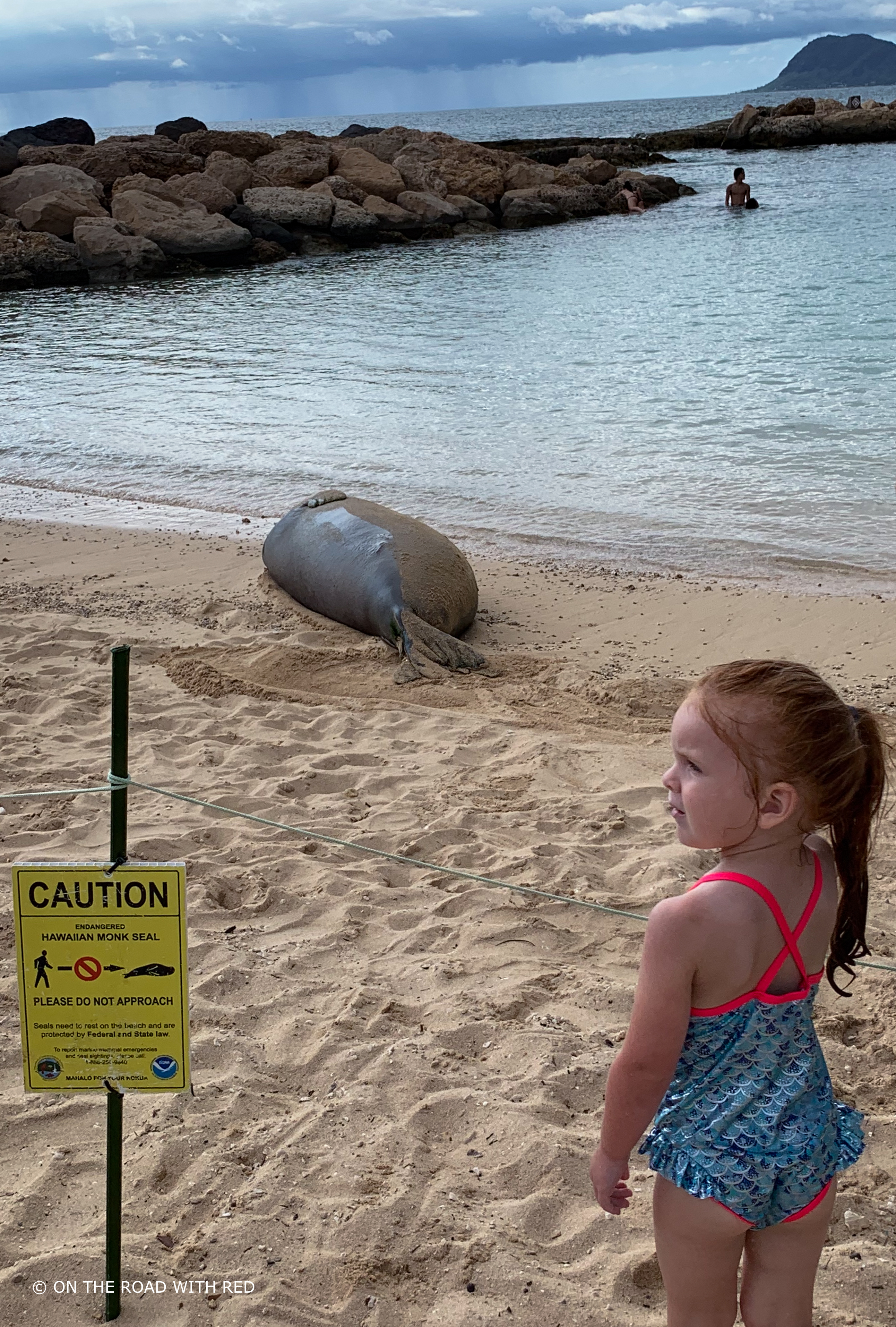
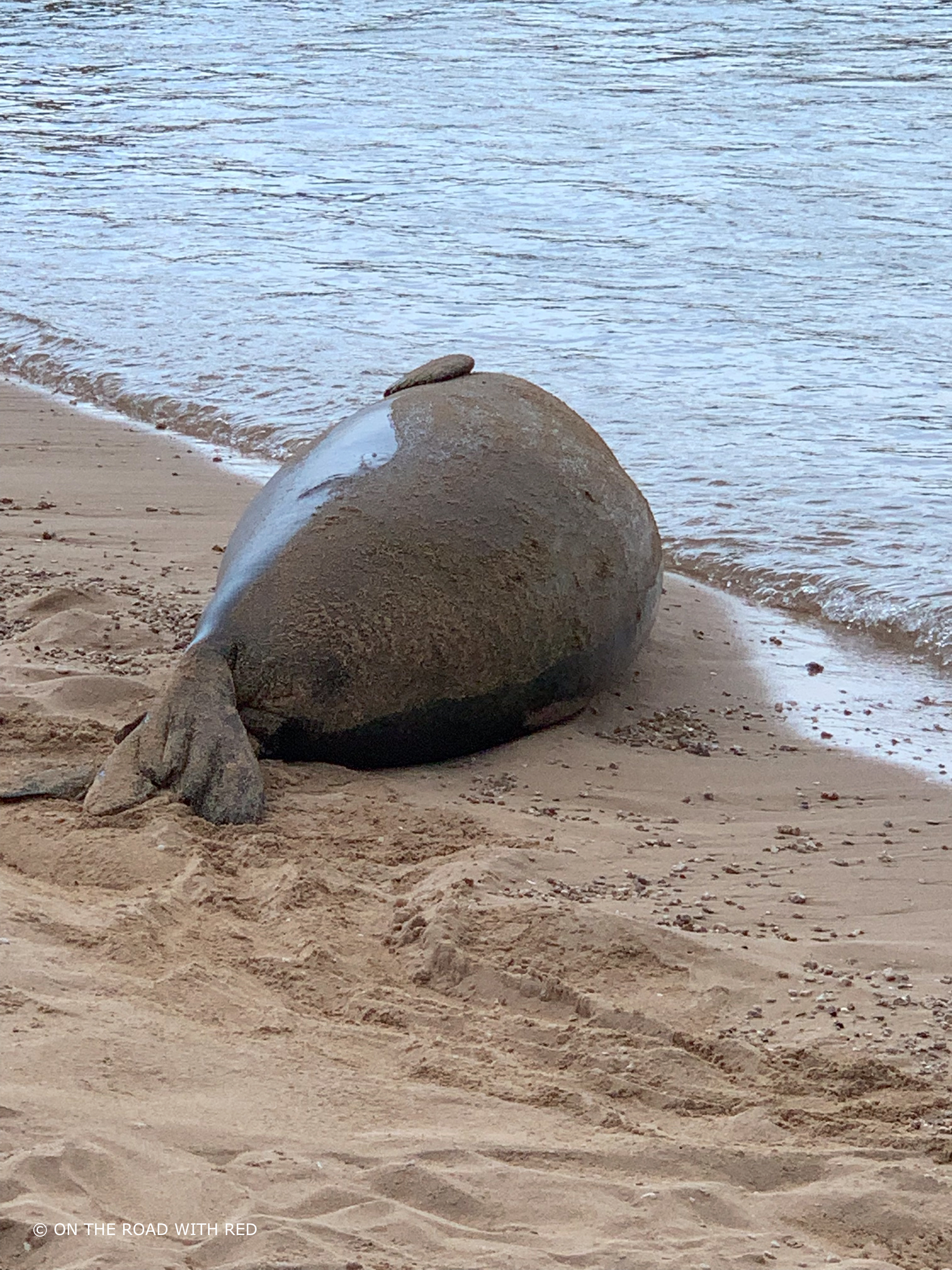
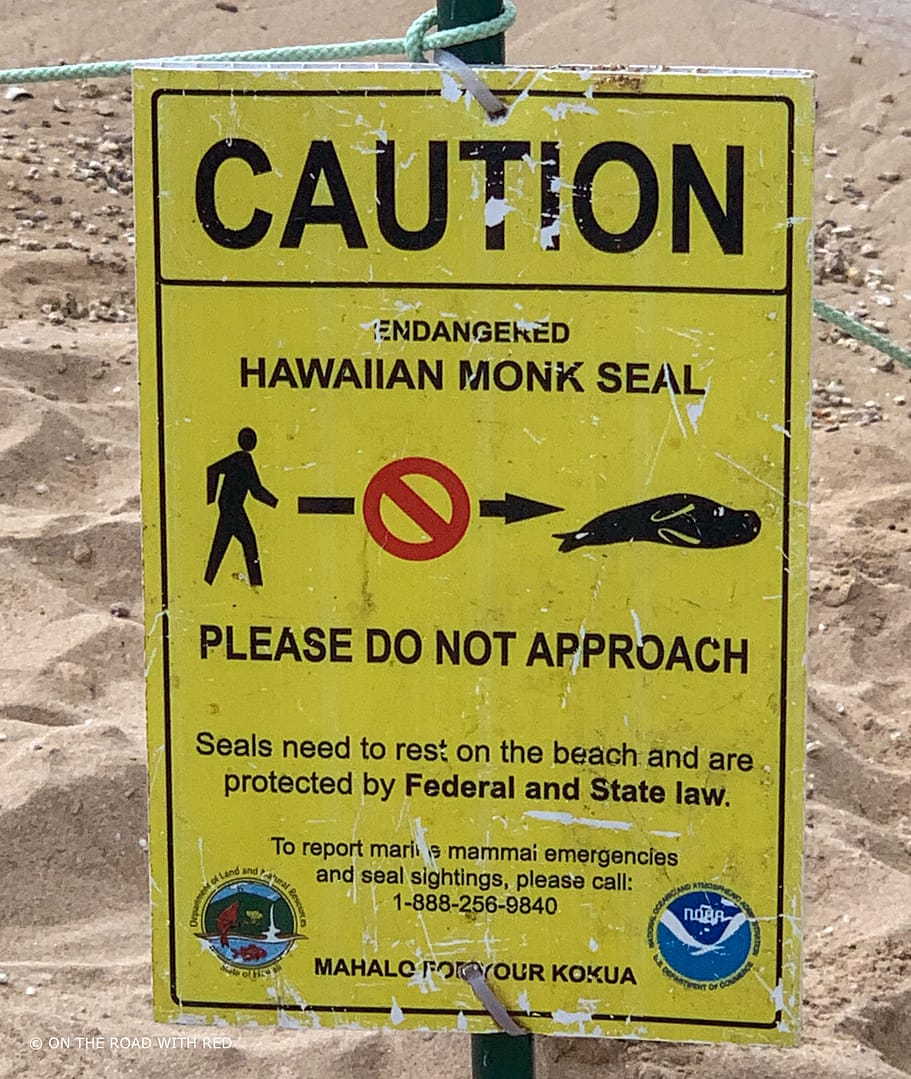
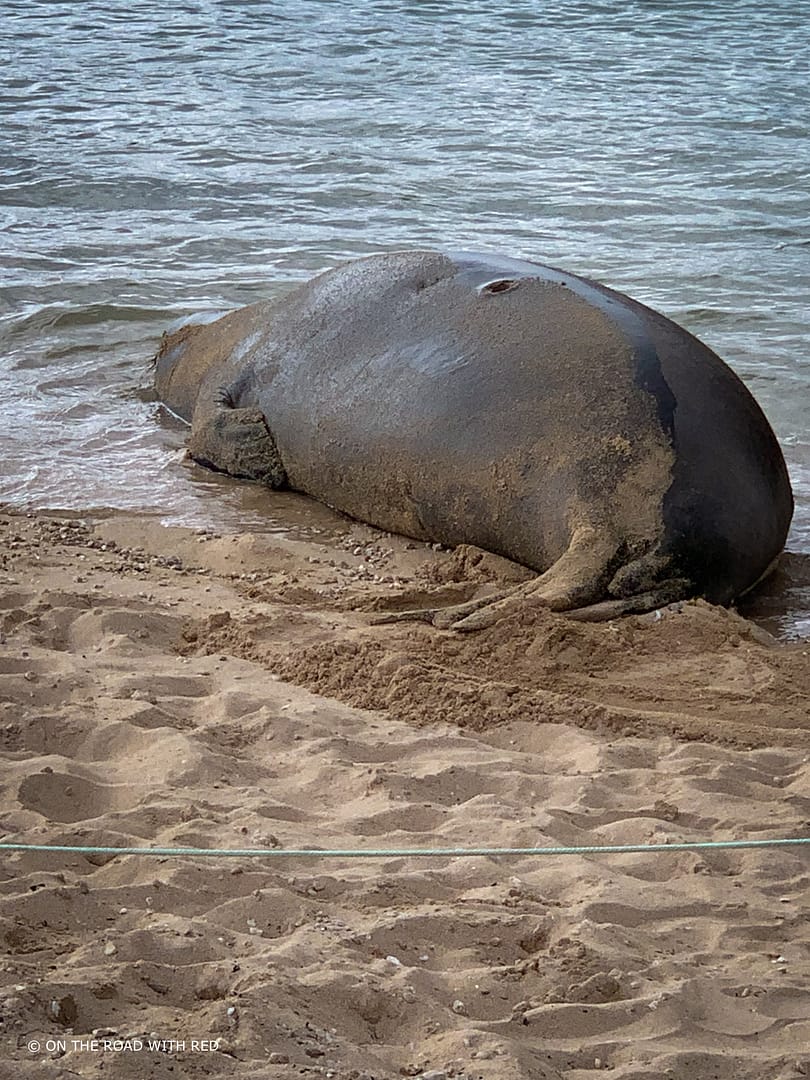
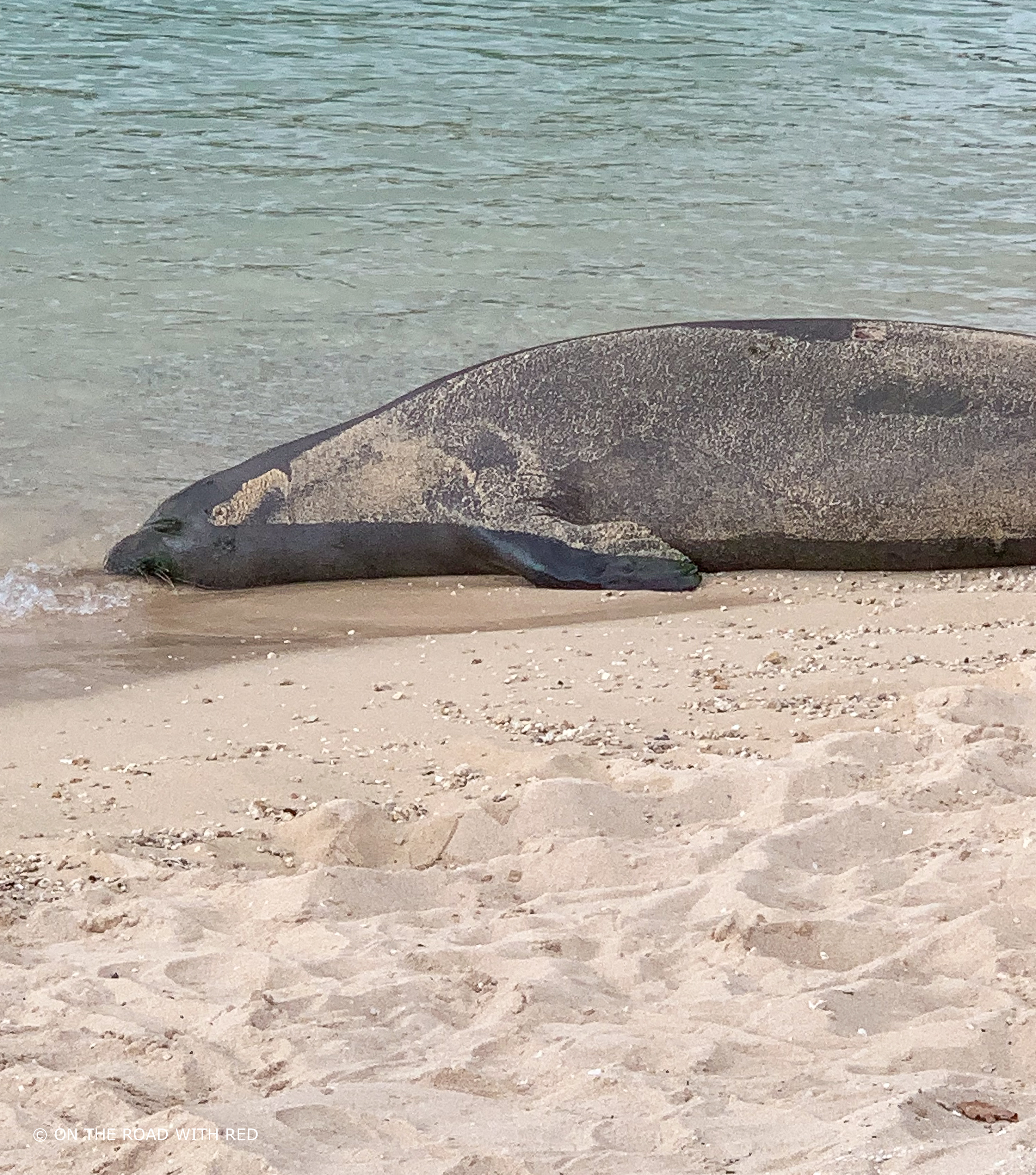
Emphasizing Conservation
The Hawaiian monk seal, a sentinel species native to the pristine waters of Hawaii, is an irreplaceable part of the region’s natural heritage and biodiversity. However, this unique species faces a myriad of threats. From habitat loss and entanglement in marine debris to the challenges posed by climate change and human activities.
The importance of conservation efforts for these seals cannot be overstated. Protecting them goes beyond saving an endangered species. It is about preserving the ecological balance of the marine environment they inhabit. The health of the Hawaiian monk seal population is indicative of the overall health of our oceans. Thus, serving as a barometer for marine ecosystem well-being. As top predators, these seals play a critical role in regulating prey species populations and contributing to biodiversity.
By prioritizing their conservation, we not only ensure the survival of these majestic animals but also safeguard our marine ecosystems for future generations. In this context, conservation efforts become a vital responsibility. An essential act of stewardship toward our planet’s rich and diverse wildlife.
Conservation Initiatives
Protected Areas
Protected areas play a pivotal role in the conservation of the Hawaiian monk seal, offering sanctuaries where these endangered animals can thrive. Recognizing the critical state of the monk seal population, several marine protected areas (MPAs) have been established in the Hawaiian Islands. These MPAs provide safe havens for seals, free from the threats of fishing, human interference, and habitat destruction.
In these protected zones, Hawaiian monk seals can engage in essential behaviors such as foraging, resting, and nursing their pups without the disturbances that often occur in non-protected areas. Notably, the Papahānaumokuākea Marine National Monument, one of the world’s largest marine conservation areas, serves as a crucial refuge for many monk seals, particularly in the Northwestern Hawaiian Islands where a significant portion of the population resides.
The establishment and enforcement of these protected areas are crucial for the seals’ recovery. They ensure the preservation of key habitats and provide a controlled environment for scientific research and monitoring. Through these efforts, conservationists aim to stabilize and eventually increase the population of Hawaiian monk seals. Thus, securing their future in the wild.
Public Awareness
Public awareness and education are crucial in the conservation efforts for the Hawaiian monk seal, particularly in tourist-heavy areas of Hawaii. Despite concerted efforts to protect these endangered animals, there have been distressing instances of human-seal conflicts.
Tragically, there have been reports of seals being intentionally harmed by humans or attacked by loose dogs. Moreover, despite clear barriers and signage advising a minimum distance of 50 feet between humans and seals, some tourists and locals ignore these guidelines, leading to dangerous encounters. For example, there have been incidents where tourists, disregarding the prescribed distance, have been aggressively confronted by mother seals protecting their pups. These situations underscore the vital importance of respecting wildlife and following regulations designed to protect both humans and animals.
Educational efforts stress that it is the responsibility of each individual, on land and in the water, to maintain this safe distance, ensuring the well-being of the seals and the safety of people. By highlighting these incidents and reinforcing the rules, conservationists aim to foster a better understanding among tourists and the local community of the critical role they play in the survival of the Hawaiian monk seal. This awareness is key to minimizing harmful interactions and supporting the continued efforts to safeguard this precious species.


Research and Monitoring
Research and monitoring are fundamental to the conservation of the Hawaiian monk seal, providing critical insights into the health, behavior, and threats facing this endangered species. Scientists and conservationists undertake extensive field studies, tracking seal populations across the Hawaiian archipelago, particularly in key habitats.
These efforts involve tagging and monitoring individual seals, which helps in understanding their movement patterns, foraging behavior, and breeding habits. Health assessments are also a significant part of the research, allowing for the early detection and treatment of diseases and injuries, which are crucial for improving survival rates. Photographic identification and genetic studies have been instrumental in understanding the population dynamics and genetic diversity of the species.
Additionally, monitoring programs focus on assessing the impact of human activities and environmental changes on the seals. This ongoing research is vital in formulating effective conservation strategies and policies. It also helps in identifying critical habitats that need protection and in evaluating the success of current conservation measures. Through this rigorous research and monitoring, scientists aim to gather the data necessary to ensure the Hawaiian monk seal’s recovery and long-term survival.
Rescue and Rehabilitation
Rescue and rehabilitation efforts for the Hawaiian monk seal play a vital role in the survival and recovery of this endangered species. These initiatives are often spearheaded by dedicated conservation organizations and wildlife agencies, who respond to reports of seals in distress, whether due to entanglement in marine debris, injuries from human interactions, or health issues like malnourishment or disease.
Once rescued, the seals are brought to specialized facilities where they receive comprehensive medical care and rehabilitation. The goal is to nurse them back to health and eventually release them back into the wild. Rehabilitation efforts are carefully monitored and often involve a combination of veterinary care, nutritional support, and in some cases, behavior conditioning to ensure the seals can successfully readapt to their natural habitat. The success of these rescue and rehabilitation operations not only boosts the survival rates of individual seals but also contributes to the overall population’s resilience.
Moreover, these efforts provide valuable opportunities for research and education, increasing understanding of the species and raising public awareness about the challenges they face. The dedication and expertise involved in these rescue missions underscore the commitment to preserving the Hawaiian monk seal and maintaining the health of marine ecosystems. Organizations like the Marine Mammal Center are involved in such rescue operations.
Your Role in Their Survival
The role of humans in the survival of the Hawaiian monk seal is crucial and multifaceted. As stewards of the environment, humans have the responsibility and the power to make significant positive changes. This involves actively participating in conservation efforts, which include supporting habitat protection, adhering to fishing regulations to prevent overfishing, and engaging in responsible tourism practices.
Public awareness plays a pivotal role; educating oneself and others about the plight of these seals and the importance of maintaining a safe distance to avoid disturbances is essential. Participation in beach cleanups and reducing overall environmental footprint also contribute to a healthier marine ecosystem, benefiting the monk seals.
Furthermore, supporting and collaborating with organizations dedicated to the research, monitoring, and rehabilitation of Hawaiian monk seals can amplify conservation efforts.
- Respect Their Space: Maintain a safe distance and ensure dogs are kept away if you encounter a monk seal on the beach.
- Proper Disposal: Dispose of trash and marine debris responsibly to prevent entanglement.
- Support Conservation: Contribute to organizations and initiatives dedicated to Hawaiian monk seal conservation such as NOAA’s Monk Seal Research Program.
Reporting sightings of distressed or entangled seals to appropriate authorities is another critical action that can save lives. Through these collective actions, humans have the ability to not only halt the decline of the Hawaiian monk seal population but to foster an environment where they can thrive for generations to come.
Conclusion
The Hawaiian monk seal is more than a Hawaiian symbol; it’s a vital part of the state’s unique ecosystem and cultural heritage. By raising awareness, supporting conservation efforts, and making environmentally conscious choices, we can help ensure future generations have the privilege of witnessing these magnificent creatures in their natural habitat. The Hawaiian monk seal epitomizes the beauty and fragility of Hawaii’s oceans, and collectively, we can act as their guardians.
Last Updated on December 8, 2023 by On the Road with Red
